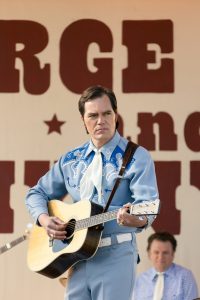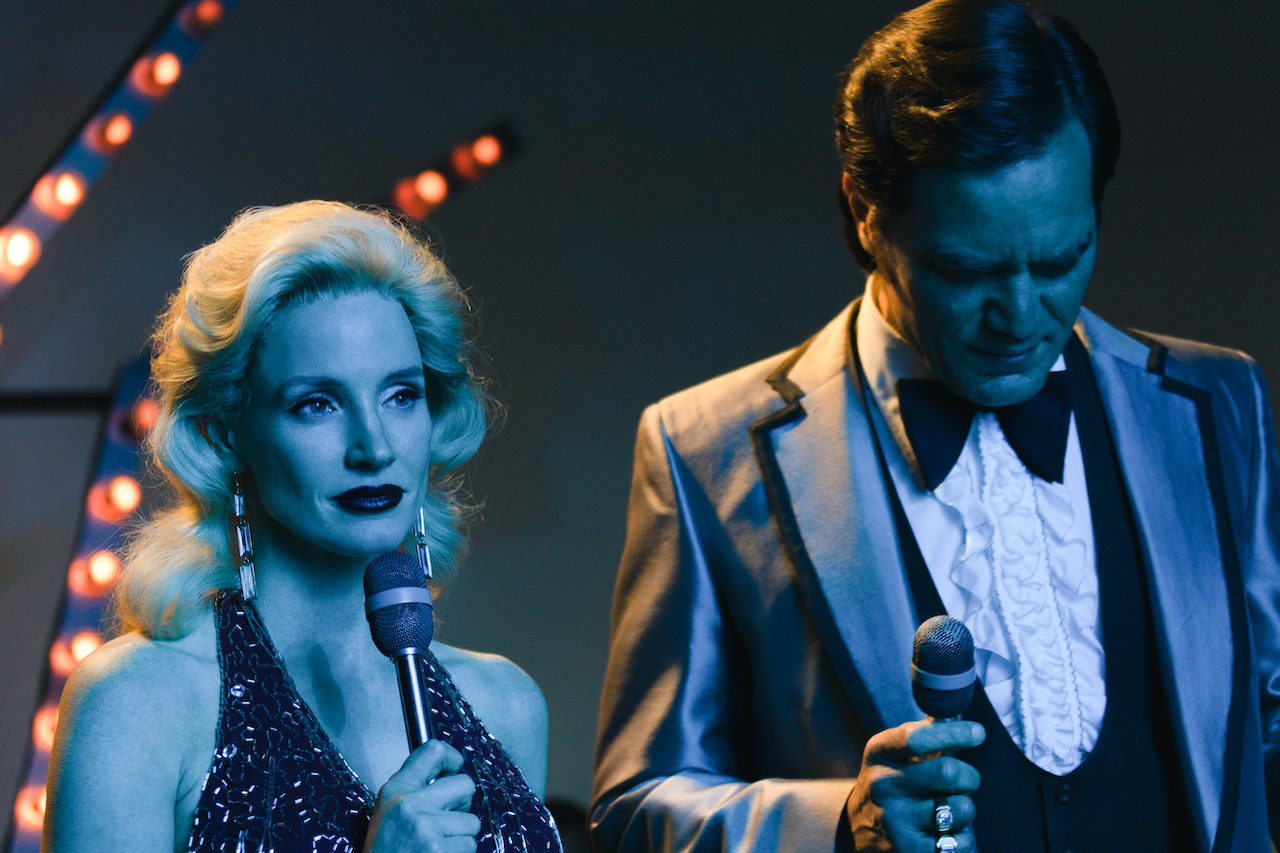Happy at home doesn’t make hits – George Jones
This adage holds true, especially in the case of the tumultuous romance between famed country musicians Tammy Wynette (Jessica Chastain) and George Jones (Michael Shannon). It all began when writer/ director Abe Sylvia (Dead To Me, The Eyes Of Tammy Faye) received a phone call from Showtime executives inviting him to create a television series about the duo. He was on board right away.
Abe Sylvia grew up in the bible belt of Oklahoma and was constantly surrounded by country music during his formative years. “It’s part of my DNA. Country music sums up a large part of American culture of pain, struggle and bloodshed. It’s a reflection of where we’ve come from and where we’ve been. It’s truly an American idiom,” mused Sylvia.

Abe Sylvia. Photo by Joe Viles/ FOX
Tammy and George were not simply composers who tapped into the vein of America. “They sought salvation in each other. They found inspiration.” Tammy saw her hero, her savior in George Jones. She finally left an abusive marriage and fell in love with Jones. “George saw in Tammy, a person who was as talented as he was. She forgave and understood him when he had so many doubts about his worthiness.” The complemented and supplemented each other’s passions in many ways.
As their relationship progressed, the dynamics lent themselves to testing the limits of forgiveness of bad behavior. Despite George’s increasingly irrational outbursts, Tammy never stopped loving him and he her. They were connected on a deeply personal level.
George and Tammy’s daughter Georgette Jones (who wrote the book The Three Of Us: Growing Up With George And Tammy) said that her mother declared that George was the love of her life up until her final days. George and Tammy were soulmates, performers, and business partners. “They had to live in all three of these realms and the balance between them was impossible to achieve.” Fissures started to appear as they became more successful.
“Their success was based on their chemistry,” continued Sylvia. “That’s not definable. It’s lightning in a bottle.” There was also a confusion between them as they pitted their intimacy with commercialism. “On some level, the only place where their relationship truly worked was when they were on stage.” Their success was cemented by the thousands of adoring fans celebrating their love and their music spurring them on. “They lived their most intimate truth in front of thousands of people.”
Sadly both were addicts to temper the pain they sang about. Tammy numbed hers with medication and George his with alcohol. The show went on… for most days.
Applause is an amazing salve for pain – Abe Sylvia
Rest And Restlessness
George spoke of being a performer in terms of “rest and restlessness.” The extreme heights needed to be offset against the need to become a normal person again. “That’s where the trouble starts between intense stimulation and isolation,” said Sylvia. This gives the audience a window into the soul of a sensitive artist with a harsh drunken exterior. “He was a gravely sensitive human being which is why he drank,” added Sylvia. “It’s hard to be that tapped in the continuum of emotional consciousness of humanity and still be a normal person.” Sadly Jones became trapped in a vicious cycle because he became a terrible person when he drank.
“George and Tammy barely kept it together even while on stage. They flew too close to the sun.” George was infamously known as “No Show George” and sometimes let Tammy sing alone on stage. “Addiction contributed to their functionality as stars, not necessarily to their functionality as human beings.”

George Jones (Michael Shannon). Photo by Dana Hawley/ SHOWTIME
That pain is why the audience loved them. “They’re singing directly to you, not about you. That visceral naked emotion provides a salve for other people. They bled on their albums.”
Abe Sylvia consulted extensively with Georgette Jones as well as others who knew George and Tammy to shape an accurate profile of their lives. “Georgette wanted the truth out there.” Sylvia’s extensive research allowed there to be more in the series than in the book. “All Georgette asked was that we try to understand her parents and not sensationalize moments in their lives which were already sensational.” There are many tall tales of country music folklore surrounding George and Tammy. Sylvia included heightened moments in the TV show, “but they’re not drawn cartoonishly or there for shock value.” Rather than outrageous behaviors, Sylvia was more focussed on their connection to each other at any given point in time.
George and Tammy is a love story, not a biopic.
Sylvia spoke with Georgette’s brothers and sisters, Jan Smith (Tammy’s best friend and hairdresser played by Katy Mixon), Charlie Pride, Billy Sherrill’s daughter and Charlene Montgomery (Kate Arrington) and Peanutt Montgomery (Walton Goggins). “Peanutt and Charlene were conduits in how we shaped George.”
One of the more noteworthy statements made by Georgette was, “My mother’s life was not a tragedy,” despite her “woe is me” songs and her tragic death. Georgette mentioned that Tammy came to Nashville in 1968 with three babies and hit the top of the charts within eighteen months. We should focus on her accomplishments not her shortcomings. “My mother was a force of nature not a doormat. Don’t be blinded by the tropes and iconography of Tammy Wynette represents.” This was instrumental in avoiding portraying her as a victim of circumstance. George Jones said in an episode, “There’s no stopping her and that’s her beauty. She has to keep going.” When George suggested they go on hiatus, Tammy flatly refused. “Getting on the bus and performing is what’s keeping me alive.”
Despite the wheels coming off the bus, George and Tammy shared many tender moments. In the pilot episode, George sings Why Baby Why. He says, “I can’t live without you so what’ll I do?” Tammy shrugs, smiles and looks at him. It’s the first time they sing on stage together and it reveals their true connection.

Tammy Wynette (Jessica Chastain) Photo by Brownie Harris/ SHOWTIME
George and Tammy were real artists. “They felt that they couldn’t perform a song that wasn’t truthful. They were very ‘in the moment’ while also being tabloid fodder. They embraced their experience and hoped someone liked it.”
Audiences are more accepting of deeply flawed characters on our screens, even if there isn’t a redemption or substantive transformation at the end. It’s a more realistic representation of humanity. “We’re in a time where we’re reappraising our heroes on TV. We’re worried about cancel culture and doubting how audiences might invest in problematic characters. Our job as writers is to write about such people and reflect humanity back at itself. We don’t progress by ignoring the dark corners,” maintained Abe.
Connecting with characters on screen is a reflection of ourselves. “We’ve all fallen in love with somebody we knew wasn’t right for us even if it’s not to that extreme. That’s a very relatable human experience. Do we not write about them?” asked Sylvia. Anti-heroes are still heroes.
Abe Sylvia loves writing about anti-heroes because they are more interesting than perfect people. “I’ve carved a space where I humanize extreme people in my writing.”
Sylvia got his showbiz start as a dancer and met plenty of extreme people to draw inspiration from – lioness women, fabulous gay men, drunks, drug addicts, and hilarious people who knew how to crack a joke no matter how down they were on their luck. “It’s a mashup of my experience. I’m the sum of all these parts.”
The writer was more focused on capturing the true spirit of George and Tammy on the page rather than putting his fingerprints on the page. “We wanted to be as seamless as possible. Putting your thumb on the scales is a real problem when writers insert themselves into the historical context of the story. It can be a real trap. Just tell the story in real time.” It’s about the characters, not the writer.
